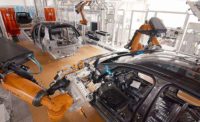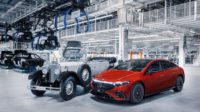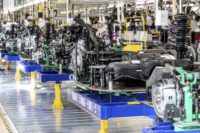Renault Group’s Douai factory in northern France has assembled more than 10 million gas-powered vehicles over the last five decades. The plant with a past was recently overhauled as a factory of the future to mass-produce electric cars.
The goal of the initiative was to create a flexible assembly line using state-of-the-art technology. The highly versatile facility can now produce both ICE and EV vehicles on the same line, with three different platforms.
In the past, the plant assembled popular vehicles such as the Renault 5 and the Renault 14. Today, its flagship product is the Megane E-Tech, a sporty compact crossover that has a range of 225 miles. The EV recently received a Euro-NCAP 5-star safety rating.
The Douai facility is part of Renault’s ElectriCity initiative, which also includes plants in Maubeuge and Ruitz. The automaker is creating the largest EV production hub in Europe, with a target of 480,000 vehicles per year by 2025. ElectriCity will also feature two nearby battery factories that are currently being built in partnership with AESC Envision.
During an intense seven-week retooling process, the Douai factory was emptied and the entire first floor was removed. More than 100 pieces of heavy production machinery were carted away, along with 400 workstations. In fact, only about 20 percent of the old assembly line was reused.
“One of the objectives of the modernization [effort] was to improve the efficiency of the production process for the benefit of workstation ergonomics and operator safety,” says Régis Monin, chief of the assembly department at the Douai plant. “The new assembly line is more compact than the old one. Approximately 20,000 square meters of floor space has been freed up to allow for the installation of a battery pack assembly [department].
“[Our] new assembly line uses the latest technologies within the Renault-Nissan-Mitsubishi Alliance,” claims Monin. “It also enables energy savings, because the old lights were replaced by LED [fixtures].
“This massive upgrade was a unique opportunity for [our] ergonomic experts to thoroughly improve and optimize workstations so that production tasks can be carried out in an easier, more fluid manner,” explains Monin.
According to Monin, one of the biggest changes to the plant is a new skillet conveyor system. “Each vehicle is laid on a skillet that acts as a base that can be raised or lowered anywhere between 20 centimeters and 1.3 meters high to make it easier for operators to work,” he points out. “This is a huge improvement over the old system.
“Skillet conveyors enable assemblers to [ride on the assembly line] 90 percent of the time, using variable work heights,” Monin points out.
The assembly line is equipped with state-of-the-art error-proofing technology that features an “anti-oversight system” to ensure that operators perform the correct task or operation.
“We are also developing training with augmented reality glasses,” says Monin.
Another upgrade to the 53-year-old Douai plant is the use of automated guided vehicles (AGVs) for material handling and line-side parts delivery applications.
“Tool trolleys have been integrated into the line to deliver parts,” explains Monin. “The serving carts containing the tools are integrated into the line and follow it while attached to the AGVs.
“[Operators] no longer perform unnecessary gestures or wasted motions, as they have everything they need next to them,” says Monin. “With everything at their fingertips, they don’t have to move about as much. Less travel and less handling mean less fatigue and more productivity, without the risk of wrong or damaged parts. That has improved quality.
“The development of full kitting stations makes the workstations more efficient, because employees are now focused on assembly tasks and not on the parts they have to put into the car,” notes Monin.
“[Our] external and internal logistics system has also been completely redesigned,” adds Monin. “Truck unloading docks and the parts department are now adjacent to the assembly line.”









